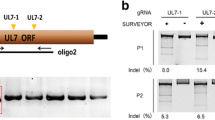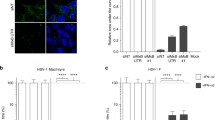Summary
Earlier studies concerning γ 1 gene regulation by the α 4 protein, the major regulatory protein of herpes simplex virus 1 (HSV-1), in stably transformed cell lines, reported conflicting results, i.e., α 4 protein positively regulated the γ1 gB gene in α 4/gB cells, while it negatively regulated the γ1 gD gene in α 4/BJ cells. Both cell lines were derived from a common parental cell line α 4/c 113 that contains 1 copy of the α 4 gene, and the only apparent difference between them was the relative copy number of the gB and gD sequences (1 and 30–50, respectively) resident in the cell genome. We investigated this disparity by constructing a cell line (BA 4) that contains one copy each of the α 4 and γ1 gD sequences, by fusion of α 4/c 113 and BJt cells, containing and expressing respectively 1 copy of the α 4 and gD genes. BA 4 cells constitutively expressed both the α 4, gD genes inherited from the parental cell lines (α 4/c 113 and BJt). In BA 4 cells the α 4 protein positively regulates the gD gene as evidenced from (i) higher levels of gD expression than the parental BJt cells lacking the α 4 gene, and (ii) significant decrease in gD expression under conditions that render the α 4 protein produced in BA 4 cells non-functional. In addition the γ2gG gene contained within the DNA fragment encoding the gD gene, is also expressed in BA 4 cells. On the basis of these data, we propose that γ gene regulation by the α 4 protein is affected by the relative copy number of these genes, resident in the cell genome.
Similar content being viewed by others
References
Ackermann M, Longnecker R, Roizman B, Pereira L (1986) Identification, properties, and gene location of a novel glycoprotein specified by herpes simplex virus 1. Virology 150: 207–220
Arsenakis M, Hubenthal-Voss J, Campadelli-Fiume G, Pereira L, Roizman B (1986) Construction and properties of a cell line constitutively expressing the herpes simplex virus glycoprotein B dependent on functional α 4 protein. J Virol 60: 674–682
Arsenakis M, Campadelli-Fiume G, Roizman B (1988) Regulation of glycoprotein D synthesis: Does α 4, the major regulatory protein of herpes simplex virus 1, regulate late genes both positively and negatively? J Virol 62: 148–158
Arsenakis M, Tomasi LF, Speziali V, Roizman B, Campadelli-Fiume G (1986) Expression and regulation of glycoprotein C gene of herpes simplex virus 1 resident in a clonal L-cell line. J Virol 58: 367–376
Braun DK, Pereira L, Norrild B, Roizman B (1983) Application of denatured, electrophoretically separated, and immobilized lysates of herpes simplex virus-infected cells for detection of monoclonal antibodies and for studies of the properties of viral proteins. J Virol 46: 103–112
Cohen GH, Isola VJ, Kuhns J, Berman PW, Eisenberg RJ (1986) Localization of discontinuous epitopes of herpes simplex virus glycoprotein D: use of nondenaturing (“native” gel) system of polyacrylamide gel electrophoresis coupled with Western blotting. J Virol 60: 157–166
Cohen GH, Wilcox WC, Sodora DL, Long D, Levin JZ, Eisenberg R (1988) Expression of herpes simplex virus type 1 glycoprotein D deletion mutants in mammalian cells. J Virol 62: 1932–1940
Davis LG, Dibner MD, Battey JF (1986) Basic methods in molecular biology. Elsevier, New York
Dixon RAF, Schaffer PA (1980) Fine-structure mapping and functional analysis of temperature-sensitive mutants in the gene encoding the herpes simplex virus type 1 immediate early protein VP 175. J Virol 36: 189–203
Everett RD (1986) The products of herpes simplex virus 1 (HSV-1) immediate early genes 1, 2, and 3 can activate HSV-1 gene expression intrans. J Gen Virol 67: 2507–2513
Ejercito PM, Kieff ED, Roizman B (1968) Characterization of herpes simplex virus strains differing in their effect on social behaviour of infected cells. J Gen Virol 2: 357–364
Faber SW, Wilcox KW (1986) Association of the HSV-1 regulatory protein ICP 4 with specific nucleotide sequences in DNA. Nucleic Acids Res 14: 6067–6082
Gelman IH, Silverstein S (1987) Herpes simplex virus immediate-early promoters are responsive to virus and celltrans-acting factors. J Virol 61: 2286–2296
Honess RW, Roizman B (1974) Regulation of herpes virus macromolecular synthesis. I. Cascade regulation of the synthesis of three groups of viral proteins. J Virol 14: 8–19
Honess RW, Roizman B (1975) Regulation of herpes simplex macromolecular synthesis requires functional viral polypeptides. Proc Natl Acad Sci USA 72: 1276–1280
Imbalzano AN, Shepard AA, DeLuca NA (1990) Functional relevance of specific interactions between herpes simplex virus type 1 ICP 4 and sequences from the promoter-regulatory domain of the viral thymidine kinase gene. J Virol 64: 2620–2631
Johnson DC, Smiley JR (1985) Intracellular transport of herpes simplex virus gD occurs more rapidly in uninfected cells than in infected cells. J Virol 54: 682–689
Kaufman RJ, Sharp PA (1982) Amplification and expression of sequences cotransfected with a modular dihydrofolate reductase complementary DNA gene. J Mol Biol 159: 601–621
Kieff ED, Bachenheimer SL, Roizman B (1971) Size, composition, and structure of the deoxyribonucleic acid of herpes simplex virus subtypes 1 and 2. J Virol 8: 125–132
Knipe DM, Ruyechan WT, Roizman B, Halliburton IW (1978) Molecular genetics of herpes simplex virus: demonstration of regions of obligatory and non-obligatory identity within diploid regions of the genome by sequence replacement and insertion. Proc Natl Acad Sci USA 75: 3896–3900
Kristie TM, Roizman B (1986) α 4, the major regulatory protein of herpes simplex virus type 1, is stably and specifically associated with the promoter-regulatory domains of α genes and selected other viral genes. Proc Natl Acad Sci USA 83: 3218–3222
Laemmli UK (1970) Cleavage of structural proteins during the assembly of the hand of bacteriophage T 4 (improved methods of gel electrophoresis). Nature 227: 680–685
Ligas MW, Johnson DC (1988) A herpes simplex virus mutant in which glycoprotein D sequences are replaced by β-galactosidase sequences binds to but is unable to penetrate into cells. J Virol 62: 1486–1494
Longnecker R, Chatterjee S, Whitley RJ, Roizman B (1987) Identification of a novel herpes simplex virus 1 glycoprotein gene within a gene cluster dispensable for growth in cell culture. Proc Natl Acad Sci USA 79: 4303–4307
Mackem S, Roizman B (1981) Regulation of herpesvirus macromolecular synthesis: temporal order of transcription of α genes is not dependent on the stringency of inhibition of protein synthesis. J Virol 40: 319–320
Mavromara-Nazos P, Silver S, Hubenthal-Voss J, McKnight JLC, Roizman B (1986) Regulation of herpes simplex virus 1 genes: α gene sequence requirements for transient induction of indicator genes regulated by β or late (γ2) promoters. Virology 149: 152–164.
McGeoch DJ, Dolan A, Dolan S, Rixon F (1985) Sequence determination and genetic content of the short unique region in the genome of herpes simplex virus type 1. J Mol Biol 181: 1–13
Muller MT (1987) Binding of the herpes simplex virus type 1 gene product ICP 4 to its own transcription start site. J Virol 61: 858–865
O'Hare P, Hayward GS (1985) Threetrans-acting regulatory proteins of herpes simplex virus modulate immediate-early gene expression in a pathway involving positive and negative feedback regulation. J Virol 56: 723–733
Pachl C, Burke RL, Stuve LL, Sanchez-Pescador L, Van Nest G, Masiarz F, Dina D (1987) Expression of cell-associated and secreted forms of herpes simplex virus type 1 glycoprotein gB in mammalian cells. J Virol 61: 315–325
Pereira L, Dondero D, Norrild B, Roizman B (1981) Differential immunologic reactivity and processing of glycoproteins gA and gB of herpes simplex virus types 1 and 2 made in Vero and HEp-2 cells. Proc Natl Acad Sci USA 78: 5202–5206
Pereira L, Klassen T, Baringer R (1980) Type-common and type-specific monoclonal antibody to herpes simplex virus type 1. Infect Immun 9: 724–732
Persson RH, Bacchetti S, Smiley JR (1985) Cells that constitutively express the herpes simplex virus immediate-early protein ICP 4 allow efficient activation of viral delayedearly genes intrans. J Virol 54: 414–421
Post LE, Conley AJ, Mocarski ES, Roizman B (1980) Cloning of reiterated and non-reiterated herpes simplex virus 1 sequences as Bam HI fragments. Proc Natl Acad Sci USA 77: 4201–4205
Post LE, Mackem S, Roizman B (1981) The regulation of α genes of herpes simplex virus: expression of chimeric genes produced by fusion of thymidine kinase with α gene promoters. Cell 24: 555–565
Preston CM (1979) Control of herpes simplex virus type 1 mRNA synthesis in cells infected with wild-type virus or the temperature-sensitive mutanttsK. J Virol 29: 275–284
Preston VG (1981) Fine-structure mapping of herpes simplex virus type 1 temperature-sensitive mutations within the short repeat region of the genome. J Virol 39: 150–161
Purves FC, Longnecker RM, Leader DP, Roizman B (1987) Herpes simplex virus 1 protein kinase is encoded by open reading frame US 3 which is not essential for virus growth in cell culture. J Virol 61: 2896–2901
Rixon FJ, McGeoch DJ (1985) Detailed analysis of the mRNAs mapping in the short unique region of herpes simplex virus type 1. Nucleic Acids Res 13: 953–973
Roberts MS, Boundy A, O'Hare P, Pizzorno MC, Ciufo DM, Hayward GS (1988) Direct correlation between a negative autoregulatory response element at the cap site of the herpes simplex virus type 1 IE 175 (α 4) promoter and a specific binding site for the IE 175 (ICP 4) protein. J Virol 62: 4307–4320
Roizman B, Kozak M, Honess RW, Hayward GS (1974) Regulation of herpes virus macromolecular synthesis: evidence for multivalent regulation of herpes simplex 1 RNA and protein synthesis. Cold Spring Harbor Symp Quant Biol 39: 687–701
Roizman B, Batterson W (1985) Herpesviruses and their replication. In: Fields BM (ed) Virology. Raven, New York, pp 497–525
Sears AE, Halliburton IW, Meignier B, Silver S, Roizman B (1985) Herpes simplex virus 1 mutant deleted in the α 22 gene: Growth and gene expression in permissive and restrictive cells and establishment of latency in mice. J Virol 55: 338–346
Sekulovich RE, Leary K, Sandri-Goldin RM (1988) The herpes simplex virus type 1 α protein ICP 27 can act as atrans-repressor or atrans-activator in combination with ICP 4 and ICP 0. J Virol 62: 4510–4522
Shepard AA, Imbalzano AN, DeLuca NA (1989) Separation of primary structural components conferring autoregulation, transactivation, and DNA-binding properties to the herpes simplex virus transcriptional regulatory protein ICP 4. J Virol 63: 3714–3728
Silver S, Roizman B (1985) γ2-Thymidine kinase chimeras are identically transcribed but regulated as γ2 genes in herpes simplex virus genomes and as β genes in cell genomes. Mol Cell Biol 5: 518–528
Smiley JR, Johnson DC, Pizer LI, Everett RD (1992) The ICP 4 binding sites in the herpes simplex virus type 1 glycoprotein D (gD) promoter are not essential for efficient gD transcription during virus infection. J Virol 66: 623–631
Southern PJ, Berg P (1982) Transformation of mammalian cells to antibiotic resistance with a bacterial gene under control of the SV 40 early region promoter. J Mol Appl Genet 1: 327–341
Stuve L, Brown-Shimer S, Pachl C, Najarian R, Dina D, Burke RL (1987) Structure and expression of the herpes simplex virus type 2 glycoprotein gB gene. J Virol 61: 326–335
Tedder DG, Everett RD, Wilcox KW, Beard P, Pizer LI (1989) ICP 4-Binding sites in the promoter and coding regions of the herpes simplex virus gD gene contribute to activation of in vitro transcription by ICP 4. J Virol 63: 2510–2520
Wagner MJ, Summers WP (1981) Regulation of transcription of the HSV-thymidine kinase gene in biochemically transformed cells. In: Kaplan AS, La Placa M, Rapp F, Roizman B (eds) International Workshop on Herpesviruses, Bologna, Italy. Esculapio Publ. Co., Bologna, p 39
Author information
Authors and Affiliations
Rights and permissions
About this article
Cite this article
Sivropoulou, A., Arsenakis, M. Regulation of glycoprotein D synthesis of herpes simplex virus 1 by α 4 protein, the major regulatory protein of the virus, in stably transformed cell lines: effect of the relative gene copy numbers. Archives of Virology 131, 153–168 (1993). https://doi.org/10.1007/BF01379087
Received:
Accepted:
Issue Date:
DOI: https://doi.org/10.1007/BF01379087




